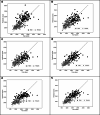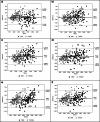New equations to estimate 24-h urinary creatinine excretion
- PMID: 40594316
- PMCID: PMC12217692
- DOI: 10.1038/s41598-025-06412-z
New equations to estimate 24-h urinary creatinine excretion
Abstract
We aimed to develop and validate prediction equations to estimate the 24-h creatinine excretion in Brazilian adults. We executed cross-sectional randomly distributed measurements in 330 adults from Vitória, a south-western Brazilian city. Anthropometry, blood pressure, and blood analytes were measured on the same day. The 24-h urine collection was initiated at the clinic and ended on the next day at home. Completeness of the 24-h collection period was confirmed by personal records in a diary. We considered valid 24-h urine collections for a period between 23 and 25 h, no report of urine loss, and volume > 500 ml. Four equations: All together with weight, height and age (WHA) and weight, height, age and lean mass (WHAL), and split by sex were developed using Least absolute shrinkage and selection operator (LASSO) regression with tenfold cross-validation iterated 50 times. Root Mean Square Error (RMSE), Mean Absolute Percentage Error (MAPE), Pearson correlation (r), Lin's Concordance Correlation Coefficient (CCC), Coefficient of Determination (R2), Median Absolute Error (MedAE), mean bias, and 95% limits of agreement (95% LOA) were used to assess their performance. From 269 participants (54% women, mean age 44.1 ± 14 years) the 24-h urine volume was 1766 ± 744 mL containing 1331 ± 399 mg creatinine (higher in men than in women; 1608 ± 337.1 vs. 1088 ± 268 mg; p < 0.01). The predicted equations by sex presented stronger correlation (r = 0.77-0.80), the lower values of RMSE (263.8-248.4) and the higher CCC (0.74-0.78). The equations including weight, age, height and lean mass were those that presented the best performance metrics. However, the equations split by sex including age, height and weight sub estimated 24-h creatinine excretion by only 0.10 mg/day, in average, with lower and upper 95% LOA - 517.2 and 517.0 mg/day, respectively. Since the developed equations showed accuracy and outperformed previous ones, we recommend their use according to variables availability.
Keywords: Equations development; Lasso; Urinary creatinine excretion; Urine collection; Validation study.
© 2025. The Author(s).
Conflict of interest statement
Declarations. Competing interests: The authors declare no competing interests.
Figures



Similar articles
-
Sertindole for schizophrenia.Cochrane Database Syst Rev. 2005 Jul 20;2005(3):CD001715. doi: 10.1002/14651858.CD001715.pub2. Cochrane Database Syst Rev. 2005. PMID: 16034864 Free PMC article.
-
Anti-interleukin-13 and anti-interleukin-4 agents versus placebo, anti-interleukin-5 or anti-immunoglobulin-E agents, for people with asthma.Cochrane Database Syst Rev. 2021 Oct 19;10(10):CD012929. doi: 10.1002/14651858.CD012929.pub2. Cochrane Database Syst Rev. 2021. PMID: 34664263 Free PMC article.
-
Corticosteroids for the treatment of Duchenne muscular dystrophy.Cochrane Database Syst Rev. 2016 May 5;2016(5):CD003725. doi: 10.1002/14651858.CD003725.pub4. Cochrane Database Syst Rev. 2016. PMID: 27149418 Free PMC article.
-
Drugs for preventing postoperative nausea and vomiting in adults after general anaesthesia: a network meta-analysis.Cochrane Database Syst Rev. 2020 Oct 19;10(10):CD012859. doi: 10.1002/14651858.CD012859.pub2. Cochrane Database Syst Rev. 2020. PMID: 33075160 Free PMC article.
-
Assessing Renal Function in Chronic Kidney Disease: A Comparative Evaluation of Glomerular Filtration Rate Prediction Equations in the North-Central Region of Nigeria.Cureus. 2025 May 21;17(5):e84577. doi: 10.7759/cureus.84577. eCollection 2025 May. Cureus. 2025. PMID: 40546627 Free PMC article.
References
-
- Hunter, R. W., Dhaun, N. & Bailey, M. A. The impact of excessive salt intake on human health. Nat. Rev. Nephrol.18(5), 321–335 (2022). - PubMed
-
- Organization WH. WHO Global Report on Sodium Intake Reduction (World Health Organization, 2023).
-
- Tanaka, T. et al. A simple method to estimate populational 24-h urinary sodium and potassium excretion using a casual urine specimen. J. Hum. Hypertens.16(2), 97–103 (2002). - PubMed
-
- Kawasaki, T., Itoh, K., Uezono, K. & Sasaki, H. A simple method for estimating 24 h urinary sodium and potassium excretion from second morning voiding urine specimen in adults. Clin. Exp. Pharmacol. Physiol.20(1), 7–14 (1993). - PubMed
MeSH terms
Substances
Grants and funding
LinkOut - more resources
Full Text Sources

